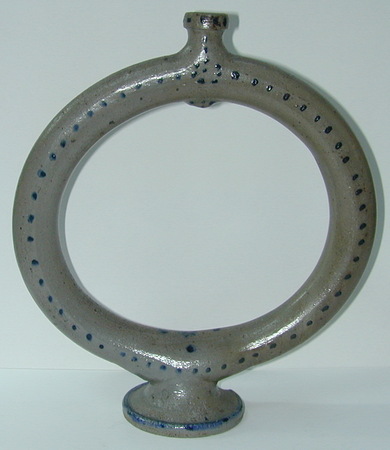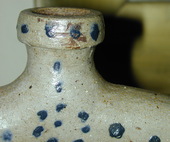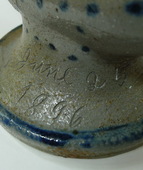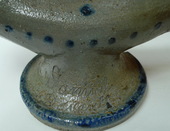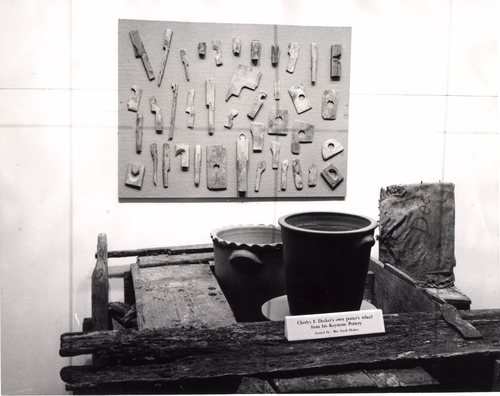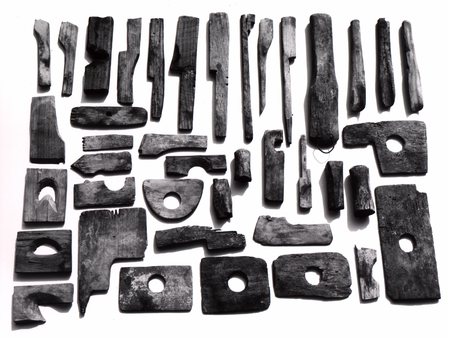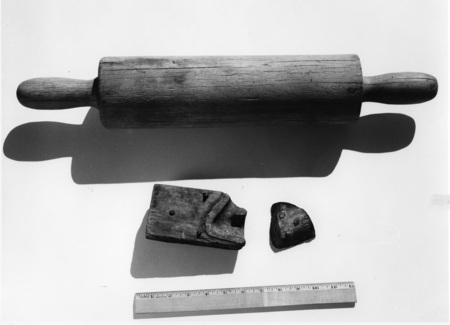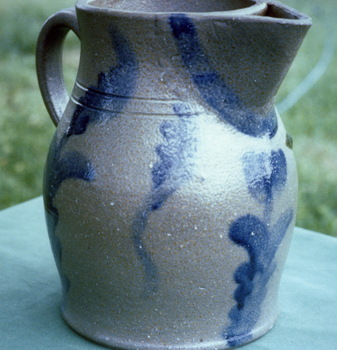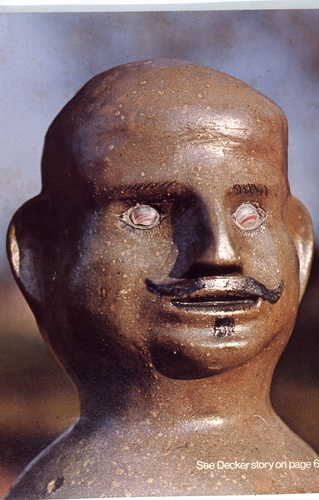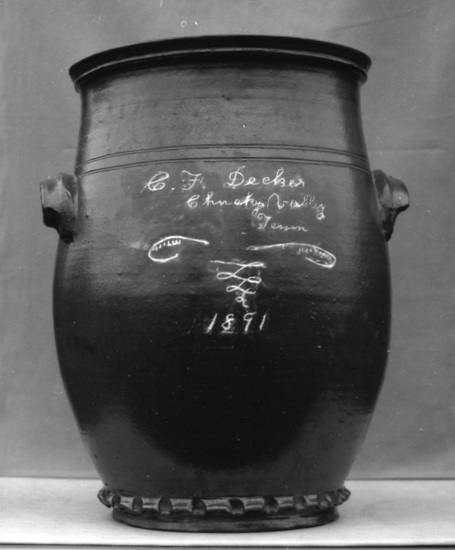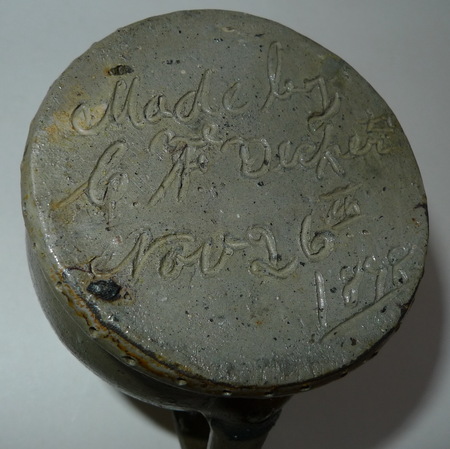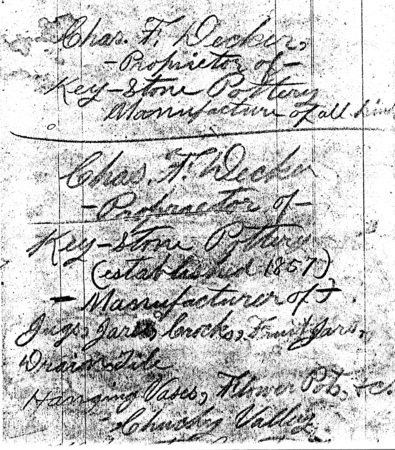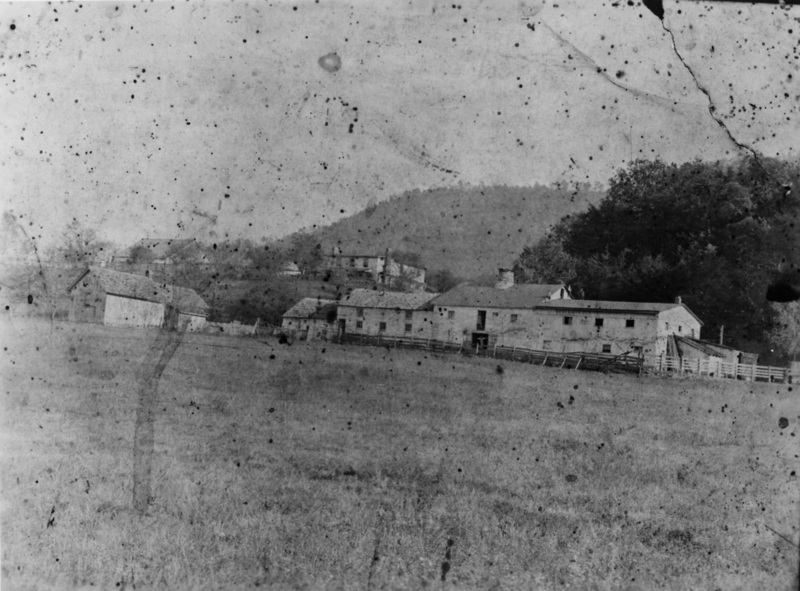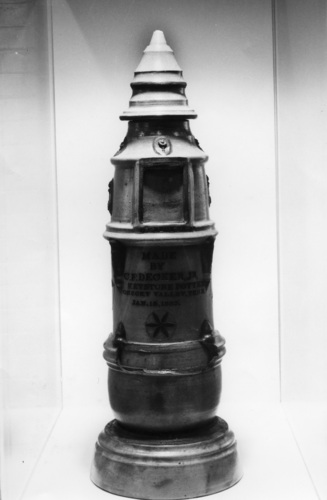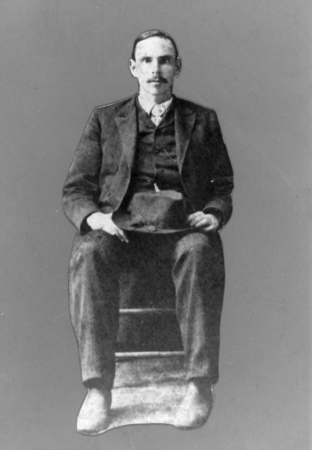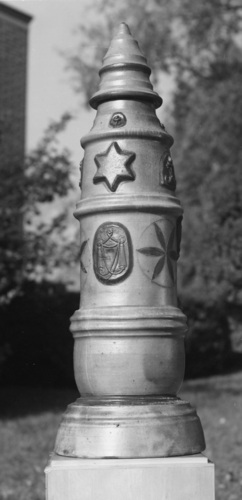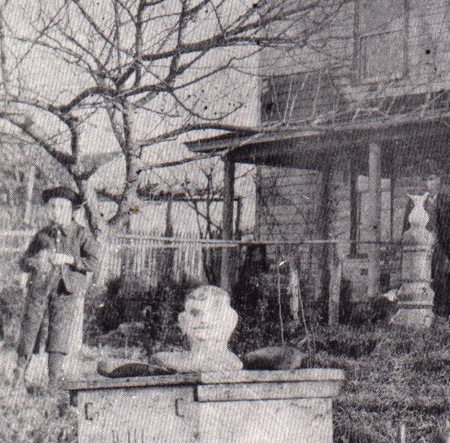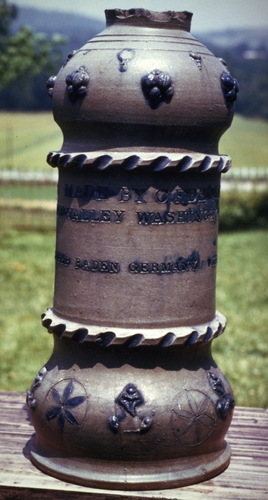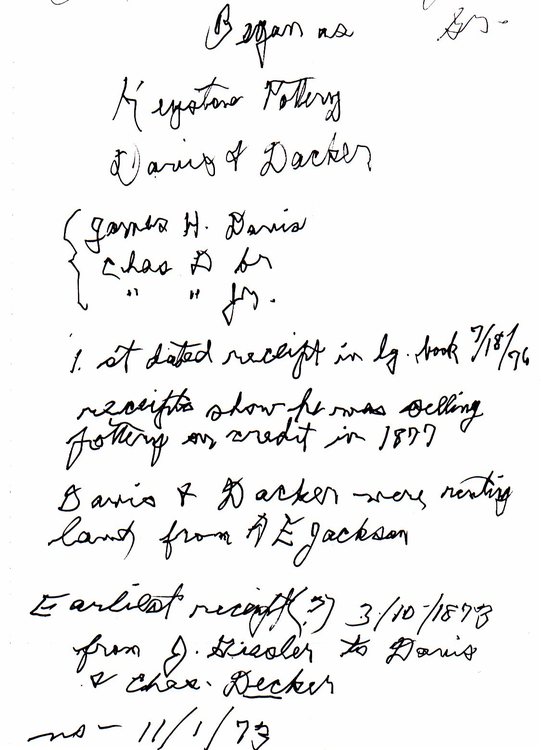Editor’s note: the following incomplete notes were found among Beverly Burbage’s papers.
The Keystone Pottery
Until a few years ago early pottery in East Tennessee was dismissed in the story of its crafts because all the known potteries were of the simple “ground hog” kiln type in which useful pots and jugs were made with passable craftsmanship but with no great attempt at quality work and decoration. Then Mr. Beverly Burbage began research on a Greene County potter of the late 19th Century. While seeking examples he ran across an old photograph of a potter at work in nearby Washington County. The remarkable variety and quality of ware illustrated led him to the site of the old pottery and to the homes of descendants still living in the area. From them he assembled a noteworthy collection of over one hundred pieces covering much of the range of objects produced.
As his collection grew, Mr. Burbage realized that Charles Decker, who had come to the Nolichucky Valley in 1872 and set up his Keystone Pottery near Johnson City, was a trained professional craftsman and a master potter. True, he had made the usual crocks, jugs, churns, and canning jars, but he and his sons, whom he had trained in his pottery, also turned pitchers, large lawn ornaments, flower pots, decorated ink-wells, and many odd and unusual pieces, including some curious grave markers. There was even a pottery “hunting horn”, weighing nearly seven pounds and giving out a doleful, foghorn sound. One son had made a six-bowled pipe which was still intact. The jar known as the Decker master-piece is an urn 26 inches tall and 55 inches in circumference, and is owned by the Reece Museum at East Tennessee State University. These and many other finely made and unique pieces clearly set the work of these craftsmen apart from that of earlier and contemporary potters of the area. Their discovery adds a new dimension to the appreciation of the crafts of Tennessee.
Charles Decker, born in Baden, Germany, in 1832, emigrated to the United States in his late teens. After working for the stoneware manufacturing company of Richard C. Remmey in Philadelphia, Decker established his own Keystone Pottery in 1857. During the early Reconstruction period, which followed the Civil War, he took his growing family and began moving southward, working at a pottery near Abingdon, Virginia, before buying about a hundred acres of land in the Nolichucky Valley. It was then about 1872. Of course, he selected the land because of the rich deposits of clay he had found on it. Again he set up a Keystone Pottery, this time with four sons to help, and later on as many as twenty-five employees. Jars, jugs and pitchers were the mainstay, and were usually sold for ten cents per gallon of capacity. Wagons delivered and peddled the pottery over a wide area during the more than thirty years of operation.
In November, 1971, an exhibition showing the full range of Decker pottery was held at the McClung Museum of The University of Tennessee, and in the following spring the Reece Museum marked the centennial of Decker’s arrival in Tennessee with a show of his work. Two articles on Decker and his work, one by Mr. Burbage and one by David Kent Miller, great great grandson of Charles Decker, appeared in the Tennessee Conservationist, November, 1971. This account of Decker pottery is indebted to these articles for its information, and to Mr. Burbage for the photographs.
How are Decker pots signed? No stamp was used as a routine procedure. Impressed letters were used on special pieces and others were scratch signed with a sharp pointed instrument of some type.
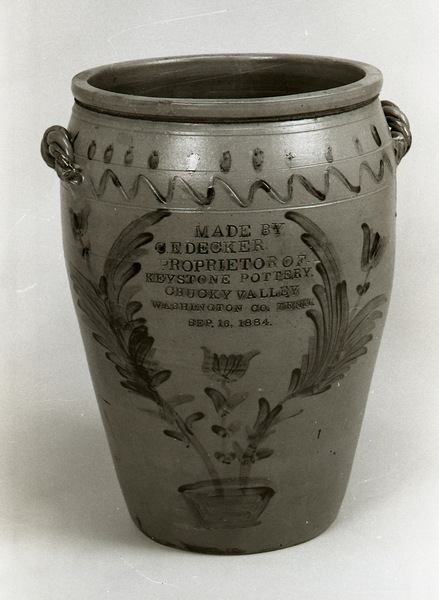
This jar, considered by many to be Charles Decker, Sr.’s masterpiece, is dated Sep. 16, 1884 and is 26 inches high and 55 inches in diameter. It won blue ribbons at regional fairs and served to advertise Decker pottery. ai20.
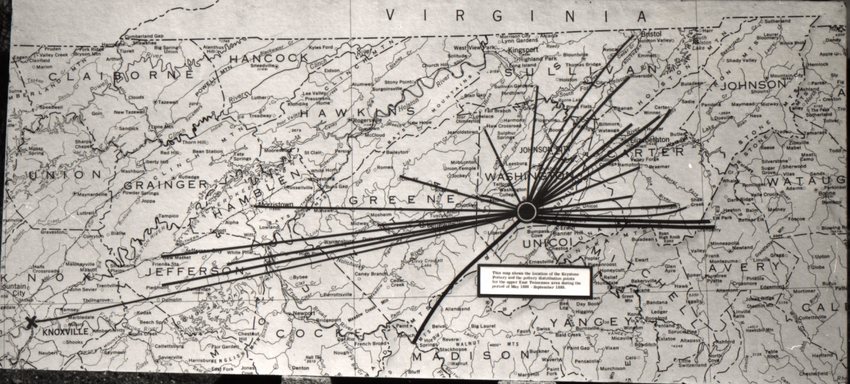
Marketing distribution map from an early exhibit. The caption reads: This map shows the location of the Keystone Pottery and the pottery distribution points for the upper Tennessee area during the period of May 1886 – September 1889. Burbage18.
Charles Frederick Decker, Jr.
October 27, 1856 – March 29, 1905
Potter Physician Veterinarian
Storekeeper Apothecary Miller Manufacturing Druggist
Editor’s note: the pages for Charles are currently missing. If they can be located they will be added here.
As the preceding page indicates, Charles Decker, Jr. was a man of varied talents. Family records and accounts indicate that of the four Decker sons only he obtained any advanced education. The schools in Philadelphia must have given him a good start, along with his younger brother, William. Fifteen or sixteen when the family settled in the Chucky Valley, Charles first enrolled at Washington College in nearby Limestone. There is no record of what he studied or of how long he attended but by 1882 he was attending Milligan College near Johnson City. Again there is no record of what courses he took or how long he stayed in college. The family did have two exercise books which show that he took some accounting and business instruction and Il. na is proof that he had become quite proficient in writing in the Spencerian style which was in fashion at the time. The account exercise books show that his writing was neat and perfectly legible. The account books kept later when he operated a general store near the pottery are largely in the same handwriting.
In the spring of 1872 Charles Decker and his family left the Abington Virginia area and headed southwest into Tennessee. Family stories give no clue as to what led them out of Jonesboro toward the Nolichucky River, but when the road which winds through low hills reached a point where the Unaka Mountains formed a backdrop for the river and the valley through which it flows they must surely have been awestruck with the beauty of the scene. Like Mormon Brigham Young when he first gazed at the valley of the Great Salt Lake, Decker may well have said “This is the place”.
So ended a journey which had begun almost a quarter of a century earlier and half a world away in the German village of Langenalb. That picturesque little town lies at the foot of the Schwartzwald Mountains in Baden near the Swiss border. From there, Decker left for America – his descendents say to avoid military conscription. Settling in Philadelphia, he used his training in pottery making to find employment with potter Richard Remmy before opening his own pottery in 1857. A few years after the Civil War he headed south, stopping briefly in the pottery center at Strasburg, Virginia before settling for a time near Abingdon in the southwest part of the state. Although not unlike the area from which he came in Germany something impelled him to move on once more. Perhaps the story of rich bottom land at the foot of a mountainside of timber may have been added to the presence of abundant clays of several types and iron, lead, and manganese to be had from the Unaka Mountains which overlooked the valley.
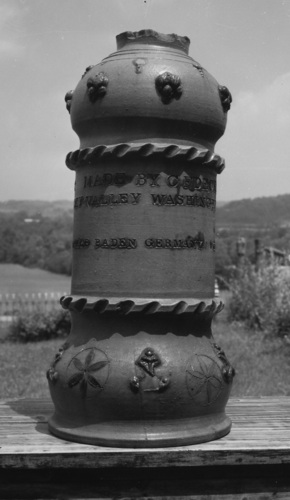
Lawn ornament made by Charles Decker, Sr. May 5, 1884. The photograph, c 1970, was taken prior to restoration of the top and bird. Burbage29.
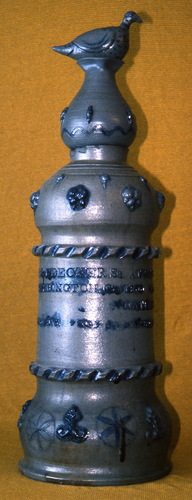
Charles Decker, Sr’s 1884 lawn ornament after restoration sometime in the 1980s. A certain amount of “artistic license” was taken in the restoration of the top as can be seen by comparing illustration 16c with this image. Burbage31.
Editor’s note: only a small number of photographs accompanied the essays. An effort will be made to obtain the missing images for this site. For the present, poor quality images were deemed better than no images. An na indicates that no image was available. An si indicates that it is a substituted image. If the source of the substituted image was Beverly Burbage a BB will be affixed. An ai indicates that it is an added image. If the original source of an added image was Beverly Burbage then Burbage will be added to the image caption.
Copyright 2009-2022, Carole Wahler
Site by GearheadForHire, LLC | v1.0.2
